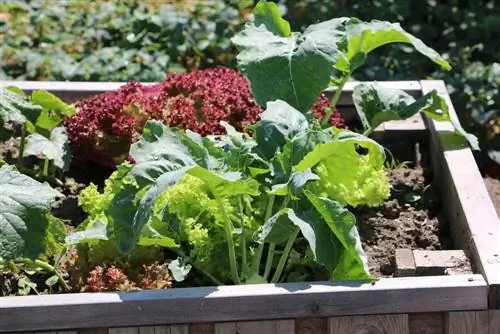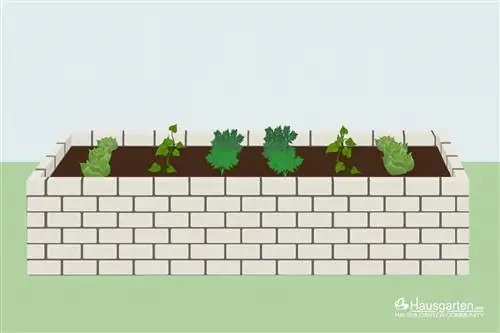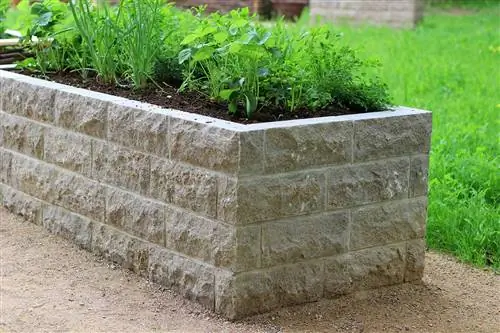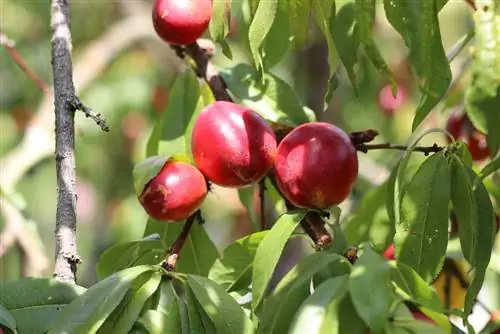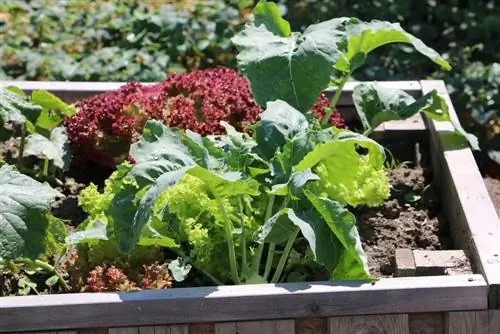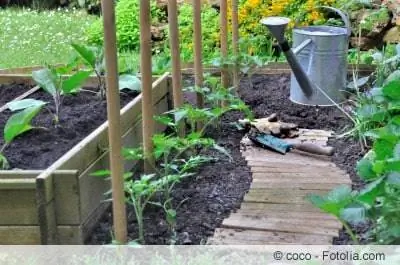- Author admin [email protected].
- Public 2023-12-17 03:39.
- Last modified 2025-01-24 12:45.
There are many reasons to purchase or build a raised bed, be it for reasons of space, unfavorable soil conditions, the sensible use of garden waste or for reasons that are easy on the back. Another advantage of this form of vegetable cultivation is that the soil warms up much more quickly, meaning that planting and harvesting can take place earlier. In order to do justice to all of this and achieve optimal yields, there are a few things to consider when building a raised bed. The foil has a very special meaning.
Film for the longevity of raised beds
A raised bed should, if possible, always be set up in a north-south orientation so that the sunlight can be optimally utilized. The prerequisite for the best possible growth is the climate in the raised bed, which ideally is always slightly moist. Too much moisture should not be able to escape or the soil should even dry out. It is precisely this moisture that can damage the respective casing if it is constructed incorrectly and the construction will fail more quickly than expected. To counteract this, raised beds, especially those made of wood, are lined with foil, because wood that is permanently damp will not last long.
Which foil should it be?
Film that you want to use to line such beds should be resilient and robust, dense and tear-resistant and, what is particularly important, ecologically harmless. It should not only protect the wood from moisture and fungal attack, but also the earth from the wood, because the wood has often been treated or impregnated with protective glazes. Substances from these glazes could end up in the soil and consequently in the vegetables. But foil is not always completely harmless. Films made of PVC, EPDM films (rubber films) and bubble wrap are most commonly used to build raised beds.
PVC pond liner
Pond liners were originally intended to hold large amounts of water, which is why they should be tear-resistant, flexible and durable as well as UV-stable. PVC films are generally not as resilient as EPDM films, for example. They age relatively quickly, lose their flexibility and the plasticizers they contain can escape. This in turn causes the film to become porous and therefore leaky.
Films for raised beds should not only be stable, but above all plant-friendly and harmless to he alth. This is exactly where the biggest mango of PVC films lies. The high flexibility of these films is due to the plasticizers they contain. As everyone now knows, plasticizers are harmful to humans and animals and unfortunately no one can say to what extent these plasticizers pollute both the earth and the crop. However, it must also be mentioned that hardly any film is completely free of any harmful substances.
EPDM film (rubber film)
The so-called EPDM film is an organic-certified pond liner without any fumes. Compared to PVC film, this has further advantages when it comes to raised beds:
- Very high tear resistance as well as elasticity and stretchability of up to 300%
- High flexibility, even at temperatures of up to -40 degrees
- Can be processed well in any season
- Is durable, UV-stable and ozone-resistant
- Compatible with plants and microorganisms, environmentally neutral
Tip:
The biggest disadvantage is the plasticizers it contains. In addition, these films are a little more difficult to lay, but this is not a problem given the generally small area of a raised bed.
Pubble foil
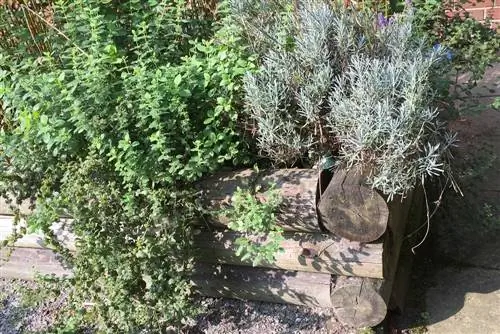
Another film that is used for raised beds is commercially available bubble wrap. As the name suggests, this film has many small nubs on one side, while the other is smooth. The side with the knobs should always face the wood, this is the only way to ensure optimal ventilation of the wood. But that's not the only advantage compared to other films.
- Pimpled foil prevents direct contact between wood and soil
- Protects optimally against rotting and fungal infestation
- Water can drain down between the knobs
- Is resistant to aging and chemicals
- It is pressure, tear, impact, wear and root resistant
- Is drinking water neutral and can be installed in any weather
- Usually does not contain any plasticizers
Tip:
An alternative to the films mentioned is a raised bed fleece made of translucent (partially translucent) PET. It can be cut to size individually, protects against pests and separates the earth from the wood or the respective border.
Raised beds that also work without foil
In addition to wood, commercially available raised beds can also be made of aluminum, plastic or patina (corroded sheet steel). While foil is indispensable for raised beds made of wood, these materials can also be used without it, although the use of foil can still be advisable for aluminum and plastic. High-quality raised beds made of aluminum are corrosion-resistant, heat-insulating and heat-retaining, and maintenance-free. Plastic is relatively weatherproof and easy to set up, but quickly becomes stained and soft due to the lack of UV protection. These plastics often also contain plasticizers.
You can do without foil altogether for raised beds made of patina, also known as Corten steel, a corroded sheet of steel with a rust patina. However, these raised beds lose material strength over the years. With a rust through time of 15-20 years, the service life of these constructions is still significantly longer than that of wood.
Conclusion
Raised beds are generally a good thing. This allows optimal yields to be achieved in the smallest of areas. It can be harvested earlier or longer and problems with pests and weeds are limited. However, moisture can cause great damage if there is not sufficient protection, especially with raised wooden beds. Foil offers good protection. Consistent avoidance can significantly shorten the lifespan of wood in particular. However, for the sake of your own he alth, you should pay attention to environmentally friendly films.

